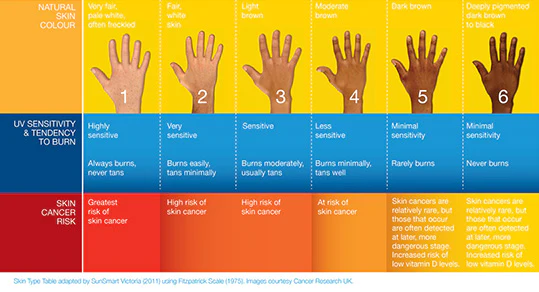Sunburn: What is sunburn?
အောက်ဆုံးထိ ဆွဲကြည့်ပေးကြပါ ခင်ဗျာ
Sunburns occur from exposure to the sun’s UV rays or UV light from artificial sources. You can usually treat first- and second-degree sunburns at home. Third-degree sunburns are very rare but need emergency treatment. A sunburn can cause premature skin aging and skin cancer. You can lessen your risk of sunburn by taking steps to protect your skin.
What is sunburn?
Sunburn is red, painful, damaged skin from being out in the sun for too long. When you get a sunburn, ultraviolet (UV) rays from the sun (or a tanning bed!) burn your skin. You don’t have to spend the day at the beach or pool to get a sunburn. Some people get sunburns doing everyday things without using sunscreen, like taking a lunch break outside, gardening or walking the dog.
Multiple sunburns can lead to premature skin aging and skin cancer. You can minimize your risk of sunburn by taking steps to protect your skin every day. It’s important to pay attention to your sun exposure when you spend any amount of time outdoors.
What are the types of sunburn?
Healthcare providers group sunburns by the severity of skin damage. The two most common types of sunburn are:
- First-degree sunburn: Damage to your skin’s outer layer. This usually heals on its own in a few days to a week.
- Second-degree sunburn: Damage to the middle section of your skin (dermis). You’ll develop blisters on the sunburned skin. Your skin may take weeks to heal, and you may need medical treatment.
A third-degree sunburn is very rare and requires emergency treatment. It severely damages all layers of your skin, including the fat layer beneath your skin. It can also destroy nerve endings. Most third-degree burns result from a chemical burn or a fire and not from sun exposure.
How common is sunburn?
Sunburns are very common, especially in young people. Between 50% and 75% of children younger than 18 have sunburns each year. More than half of adults ages 18 to 29 reported having one or more sunburns in 2015.
Symptoms and Causes
What are the symptoms of sunburn?
If you get a sunburn, your skin might feel like it’s on fire — a hot and burning sensation that gets worse when you touch it, even with clothing.
Symptoms of sunburn depend on how severe your burn is. Symptoms may include:
First-degree sunburn symptoms
- Redness on lighter skin. People with dark skin can get sunburns, but they can be harder to see unless they peel or blister.
- Skin feels hot or tight.
- Pain or tenderness.
- Swelling.
- Peeling skin (after several days).
You may also experience:
- Fatigue.
- Fever.
- Headache.
- Nausea.
Second-degree sunburn symptoms
- Extremely red skin.
- Blisters
- Swelling over a larger area.
- Wet-looking skin.
- Pain.
- White discoloration within the burn.

You may also experience symptoms of heat illness, including:
- Confusion.
- Dizziness.
- Exhaustion.
- Fast breathing.
- Fever.
- Headache.
- Muscle cramps.
- Nausea.
- Shivers.
Third-degree sunburn symptoms
- Leathery-looking burn.
- Numb skin.
- White or dull skin color.
- All the above heat illness symptoms including shock and/or heat stroke.
What are the three stages of sunburn?
While others may notice your skin turning pink in the sun, unless you’re looking in a mirror, you probably won’t notice sunburn until the pain starts. Your sunburn will go through three stages:
- Pain from sunburn usually starts within a few hours of your burn.
- Your skin will get redder and more irritated, with pain peaking at about 24 hours after your burn. If you have a second-degree sunburn, you’ll start to blister.
- Over the next week or so, your skin may peel and should gradually return to its normal shade. If you have a severe sunburn, this may take a few weeks.
What causes sunburn?
Sunburn is caused by ultraviolet rays. There are two types of UV rays: UVA and UVB. Both types of rays can burn your skin.
Anyone can get a sunburn. But your chance of getting a sunburn increases depending on:
- The amount of time you spend in the sun.
- Certain medications, including antibiotics like doxycycline and Bactrim™, nonsteroidal anti-inflammatory drugs (NSAIDs), retinoids and heart medications (like diuretics).
- Intensity of UV rays. This is affected by the time of day, cloud coverage, altitude and closeness to the equator.
- Ozone depletion, depending on where you are in the world.
- Skin type and color.
- Use of tanning beds without sunscreen.
- What is the message of the song “Imagine” by John Lennon brainly?

- What is the mean of Wind of Change ?

- The Key Vitamin That Prevents Dementia

- Coffee May Help Protect Against AFib, Challenging Advice to Avoid It
- What Is The Difference Between Being Hard of Hearing and Deaf?

- What is Respiratory syncytial virus?



Miss you 🖤
Good morning all guys ❤️🌞
Noted! Thank you.
Sunburn is caused by ultraviolet rays ☀️
I see😪
Thanks for sharing 👍
I miss you idol.🎶🎼
Raymond 🖤
💞
🖤
ရေဆာချိန်ကမ်းသောလက်များကို တွဲခေါ်ခဲ့
Thanks for sharing 🥰 love it
ရွေငွေများမှ မဟုတ်ပါ အဖိုးတန်ဆိုတိုင်းရယ်🤍🤍🤍🤍🤍
Thanks
Favorite song 🖤
I really appreciate author and admins teams.🍀I love clickers 💕💌
I really appreciate your valuable article.Thabk you so much.
Idiots 🖤
အကိုအရမ်းကြိုက်တဲ့သီချင်းလေး
Thanks 💯
Thanks.
ありがとう
Thanks
Thanks a lot for sharing this with all folks you actually recognize what you’re talking about! Bookmarked. Please additionally consult with my site =). We can have a link trade contract between us!
Thanks for sharing.
Sunburn is painful but moonburn is far wore .Will you be my sunscreen🤭
We should protect our skin from uv rays to prevent sunburn.
Sunburn is a dangerous disease to worry about. Therefore, everyone should use sunscreen.Thank you very much.
I would like to thank the person who wrote this article in this hot season of our Respect admins and Clickers.Be safe and healthy all 🌞☀️🌤️🌞💜💪💜
Umm… most of the people have got sunburn in summer 🌞, so we should aware of it. Thanks again for sharing knowledge.
This article is very compatible with present season…so hot🔥 Thanks lots…
Wow, thank you, admin, I’m currently suffering, so thank you very much. The song is very special.